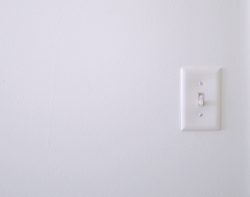I’ve never been able to take hormonal birth control. I have tried and the side effects were so extreme that I almost ended up in the ER more than once. After telling each new doctor my past horror stories, they would each reassure me that I simply had the wrong doses and had to try a different brand. I tried three times in my adult life and every single time was a disaster that seemed to progress from the last. So, I gave up on hormonal birth control.
Most women I know have been on birth control most of their adult life, some even since they were teenagers. While I always tell myself that there might be long-term side effects outside of the ‘clinical trial’ time frames (not that I wish bad health on anyone, but would be my top concern if I was on any medication long term), most women are happy poppin the pill (or now the other various forms of hormonal birth control like IUD, rings, patches, etc). Furthermore, most men are happy letting their lady take on that responsibility.
For the most part, I’m okay not being on a hormonal birth control. It is awkward when dating someone and getting to that point where things might lead to more than just dinner a movie and I have to bring up that little, unpleasant fact, but otherwise I’m happy with my natural mood swings and erratic hormones.
I’ve been with my boyfriend for over 3 years now, so I haven’t had to have “the talk” recently. However, back in my dating days, I was always shocked at how shocked men were that I wasn’t on the pill. It was like the idea of a woman not being on some form of birth control was absurd to them. What I love about Brent (well, I love a lot of things about him) is that after witnessing the extreme effects of hormonal birth control in my body first hand, he has accepted that we have to take other measures to prevent pregnancy. He’s also assured me that if a male birth control comes available he would be willing to try, but only after many clinical trials and a year or two of being on the market (I can’t blame him with the controversial drugs the FDA has approved in the past).
Male Birth Control
Turns out there are forms of male birth control. Quite a few actually and very few of them are hormonal, which would have the most risk and side effects. Some sound weird, and lots are still in clinical trials (And there is no way in hell we would even consider a clinical trial – can you imagine being in the placebo group?!). Let’s look at some of the new forms of birth control that share the reproductive responsibility.
It is important to remember that, like female contraceptives, these treatments do NOT protect against sexually transmitted diseases.
RISUG
In India, they have developed a long-term, reversible solution that is 100% effective in clinical trials. The Reversible Inhibition of Sperm Under Guidance or RISUG might be a good option if your man doesn’t mind needles. According to Techcitement the simple procedure is as follows: “A doctor applies some local anesthetic, makes a small pinhole in the base of the scrotum, reaches in with a pair of very thin forceps, and pulls out the small white vas deferens tube. Then, the doctor injects the polymer gel (called Vasalgel here in the US), pushes the vas deferens back inside, repeats the process for the other vas deferens, puts a Band-Aid over the small hole, and the man is on his way. If this all sounds incredibly simple and inexpensive, that’s because it is.” How does it work? “The two common chemicals – styrene maleic anhydride and dimethyl sulfoxide – form a polymer that thickens over the next 72 hours, much like a pliable epoxy, but the purpose of these chemicals isn’t to harden and block the vas deferens. Instead, the polymer lines the wall of the vas deferens and allows sperm to flow freely down the middle (this prevents any pressure buildup), and because of the polymer’s pattern of negative/positive polarization, the sperm are torn apart through the polyelectrolytic effect.” Another benefit, RISUG does not cause the common side effects of a vasectomy: granulomas and an autoimmune response.
Will it be approved? It has yet to get approval in India, and, according to Science Based Medicine, trials on rabbits are just starting in the US (published May 2012). Perhaps this birth control is just too good to be true and pharmaceutical companies stand to loose too much if men have to get a shot once every ten years and without side effects, are 100% reversibly infertile.
What’s more – this treatment might actually prevent HIV transmission from male to female during intercourse.
Male Hormonal Birth Control
In Denmark, studies are being conducted in hormonal birth controls that rather than taking a pill daily (because men can’t bother with that?), tiny rods are inserted under the skin of the arm that deliver the hormones. These rods deliver etongestral, a progesterone often used in female birth control pills. The etongestral blocks sperm production and is considered reversible. The downside: to block sperm production, it blocks testosterone production as well. Participants of the study have to get testosterone replacement therapy injections every 4-6 weeks to maintain their sex drive, as well as their male characteristics. If approved, patients would only have to change the rods every three years.
There are other hormonal birth controls on trial. Some involve topically applied gels, others pills, or shots every few months; but they all work the same and have the same side effect of blocking testosterone production in the testes.
Other Odd ‘n’ Ends
There are surprisingly lots of clinical trials and products out there for male birth control. And maybe not-so-surprisingly, those that were not hormonal had very few side effects. I suppose it makes sense that it would be easier to control men’s sperm that are located externally, opposed to internally manipulating our eggs.
Suspensories, a pair of brief-like garments holds the testes closer to the body, raising the temperature of the testes and suppressing sperm count and making the remaining sperm poor swimmers. Here are other heat treatments.
Intra Vas Device (IVD), is a set of implants that block the flow of sperm. According to malecontraceptives.org, “These tiny, pre-formed, flexible silicone plugs are inserted into the vasa deferentia, the tubes carrying sperm from the testes. The device is sized to the width of each recipient’s vas deferens, filling the lumen (the opening in the vas tube) but not stretching the tube. Two plugs are inserted in the same vas with a small space between them. If sperm pass around the first plug and enter the space between the two plugs, the second plug blocks them. In order to prevent the plugs from moving within the vas deferens, they are anchored with small sutures to the wall of the vas deferens itself. Once implanted, they can not be felt. The IVD is similar in function to a vasectomy, but it leaves the vasa deferentia intact.”
Hopefully these new forms of birth control will soon be on the market and women like me, who can’t or choose not to, take hormonal birth control will be able to share the responsibilities of reproduction. All I can say is it’s about damn time!
For more information on clinical trials and other treatments check out MaleContraceptives.Org, it had the most inclusive, detailed and reliable information I could find on the subject.














Very interesting! I had heard about the polymer, but not the others.
[…] Another method uses a chemical polymer to block the passage of sperm to the urethra. This polymer, known as styrene maleic anhydride, has entered phase III clinical trials in India. Lisbeth Prifogle goes into more detail about the exact mechanism used for this type of contraception in her article, Male Birth Control – Myth or Available Science. […]